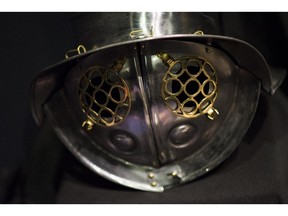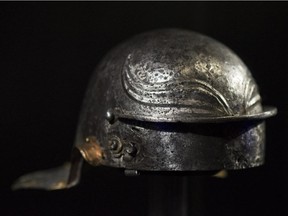what sport does the reporter compare the gladiatorial games to and why?
Gladiators were hockey players of their time, except most died on first day

Reviews and recommendations are unbiased and products are independently selected. Postmedia may earn an chapter committee from purchases made through links on this page.
Many things in the exhibition Death & Glory: Gladiators & the Colosseum, at the Canadian War Museum, made me think, "Huh, that sounds like the NHL, or any other major pro sport of today."
There are rich people in their boxed seats, and inexpensive seats for the masses. There are fan clubs and groupies; and at that place are training camps, team doctors and referees. Countless hopefuls exercise and train for the infinitesimal chance they'll be a star, bathed in riches and glory. The lucky ones who survive to career-end may even save enough money to "buy a farm, open a shop, open up a bar," says museum historian Peter MacLeod.
These circumstances were experienced by gladiators who fought at the Colosseum in Rome two,000 years agone, and are familiar to sports fans in the 21st-century. In that location are differences, near significantly that sporting events of today don't include executions, the slaughter of animals and humans fighting to the death, merely otherwise information technology's striking how little major pro sports have inverse over two millennia.
"In many ways we expect dorsum at the Colosseum and see ourselves at the (Canadian Tire Centre), where we accept a team named the Senators," notes MacLeod, who adds a reference to the Sens' gladiator-helmet logo.
Roman senators were important people in 70 A.D., when the emperor Vespasian began construction of the Colosseum. The massive project, large enough to seat 55,000 people, was financed with treasure pillaged from the Temple of Jerusalem, and congenital on the former site of Nero's palace. The choice of the site, MacLeod says, was the deed of "returning the space to the people of Rome."
Gladiators, and the games, existed long before the Colosseum was built, MacLeod says, and "seem to have begun equally funeral games, so you lot would stage a fight to the expiry at your father'south funeral, non as a spectacle of amusement — that would come after — but as a religious ritual or cede."
Sporting events at a funeral may seem horrid today — "closest horseshoe to dad's grave gets his power tools!" — only then they were a source of i-up-manship, similar keeping upwardly with the dead Joneses. Romans admired the games considering they demonstrated the force and courage of Roman civilization, and wealthy people and politicians wanted their funeral games to be the all-time.
"They become bigger and bigger until you lot have mass events, and it begins to evolve into a public spectacle," MacLeod says.
Panels throughout the exhibition explain the history of the games and the stadium. At that place are also existent pieces of the Colosseum, many finely chiselled into decorative rails or columns, including a crocodile head. "If you went to the Colosseum equally a spectator two,000 years ago, you could take walked by that crocodile head," MacLeod says, who has a knack for making history accessible.
I piece of stone once helped to hold in place the elaborate sets that would rise out from hugger-mugger to the floor of the arena — for instance, a forest would rise upwardly, and out would walk a lion, which would before long be killed. The Romans almost wiped out the lions of north Africa. In the first games at the Colosseum, which lasted 100 days, more than 5,000 animals were killed. Ii g gladiators also died.
Most gladiators were killed in their first fight, yet among the criminals and slaves and prisoners of war who were forced to fight, at that place were also volunteers.
"It'southward a risky business organization, but there'southward the hazard to go a celebrity, the equivalent of a superstar," MacLeod says. If one survived long plenty to retire from fighting, he might even observe a new career as a bodyguard for a politician. (I'll bet those politicians never had to worry most getting a pie in the face.)

The gladiators were likewise well fed, and were vegetarians — the Romans weren't so big on meat. Gladiators even had their ain sports drink, "made of vinegar and bone ash," which made information technology rich in strontium, which strengthened the basic.
Once the fighters — which were ordinarily men but included some female gladiators — got into the band, in that location was no gratis-for-all as often seen in films such as Gladiator. "What yous see would have been between ii gladiators fighting 1 another with a referee nowadays," MacLeod says. "It compares to a battle lucifer, and was very ritualized and stylized."
The weapons and armour in the exhibition include real artifacts — such as a gladius, the short sword for which gladiators were named — and reproductions. The full suits of combat gear are reproduced, whereas the helmet and other artifacts from Pompeii really were dug out of the volcanic rock of that doomed city.
There'southward a stone plaque that alleged a certain seat in the Colosseum as reserved for a rich citizen, much like companies have their names on private boxes at sports arenas today. There'southward also an anonymous seat from the Colosseum, with graffiti — a father and son belongings hands — scratched into it. All this helps to make the history accessible.
The exhibition is a thorough and entertaining wait at an age that continues to fascinate us all these millennia later on. Who could resist putting on the replica gladiator helmet at the stop of the tour? I felt like a kid again, though I didn't take some giant coming at me with sword and trident.
Five movies about gladiators . . .
Hollywood loves gladiators, though it's less fond of historical accuracy. Hither are five films about gladiators who waged battles with the facts:
Movie: Gladiator (2000)
Our hero: Russell Crowe
Premise: Maximus is to be emperor, merely is cheated by the twisted Commodus. He faces his nemesis in the Colosseum.
Dubious history: Gladiators are seen fighting as teams, as wild animals endeavour to grab them. In fact, gladiators fought one on one, without animals.
Rottentomatoes.com audience rating: 87 per cent.
Flick: Demetrius and the Gladiators (1954)
Our hero: Victor Mature
Premise: Demetrius embraces Christianity, is forced into gladiator school, amuses Caligula, meets a nymphomaniac, is saved past Peter the apostle.
Dubious history: The gladiator school, said the New York Times, "has a strong resemblance to the grooming campsite of the Chicago Bears."
RT audience rating: 66 per cent.
Moving-picture show: Spartacus (1960)
Our hero: Kirk Douglas
Premise: Based on a true story. Spartacus is a slave who inspires the Ottawa Senators' mascot, Spartacat, ii,000 years after he leads a slave revolt to go dorsum the woman he loves.
Dubious history: The Guardian notes that when captured slaves are asked which 1 is Spartacus they all shout "I'thou Spartacus!" In fact, "Spartacus was killed in battle with a spear through his thigh, stranded in the center of Roman forces by his fleeing comrades."
RT audience rating: 87 per cent
Movie: The Arena (1974)
Our hero: Pam Grier
Premise: Female slaves rebel, and must fight in the Colosseum. The film'southward subtitle is, ahem, Naked Warriors.
Dubious history: There were female gladiators, but the focus here is, equally every bit one website puts information technology, "Amazonian-similar Grier and her statuesque Nordic analogue (Margaret) Markov delivering the goods for the corrupt rubberneckers occupying the cheap seats."
RT audition rating: 25 per cent
Movie: Gladiators 7 (1962)
Our hero: Richard Harrison as Darius
Premise: Rich man is framed, and and so sentenced to fight in the Colosseum.
Dubious history: Loosely based on the archetype Western The Magnificent Vii (which was based on the classic Kirosawa film The Seven Samurai), and 1 online critic notes, "you wonder how even the best gladiators tin match a complete army."
RT audition rating: 33 per cent
-thirty-
Death & Celebrity: Gladiators & the Colosseum
When & where: to Sept. 7 at the Canadian State of war Museum
Click hither to read more from The Big Beat
psimpson@ottawacitizen.com
twitter.com/bigbeatottawa
Source: https://ottawacitizen.com/entertainment/local-arts/gladiators-were-hockey-players-of-their-day-except-that-most-of-them-died-on-their-first-day

0 Response to "what sport does the reporter compare the gladiatorial games to and why?"
Post a Comment